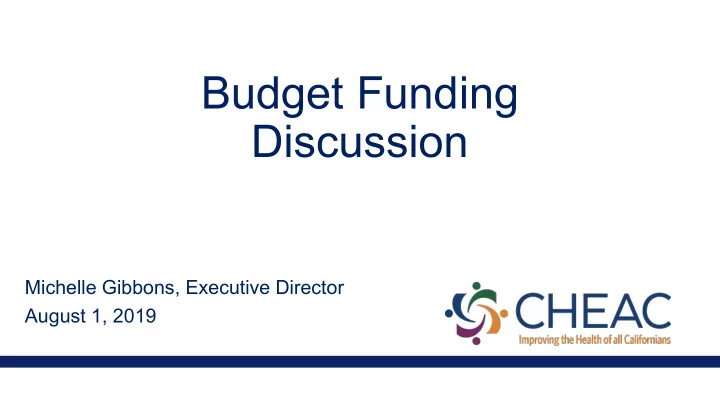

Budget Funding Discussion Michelle Gibbons, Executive Director August 1, 2019
Infectious Disease Funding ($40m) • $ 40m one-time GF • $4m state admin. • Up to $1m tribal communities • At least $35m to LHDs • Funding provided in lump sum amount in FY 2019-20; available for expenditure for 4 years until 6/30/2023 • CHEAC provided a recommended allocation to CDPH Question: How does your LHD intend to use the funding?
STDs, HIV, HCV Budget Act Funding STDs HIV HCV Total Amount $5 million $5 million $5 million State Admin $500,000 $500,000 $500,000 Who does funding go to? LHDs LHDs and CBOs; LHDs competitive awards Funding distribution LHDs required to provide CDPH required to provide LHDs required to provide requirement at least 50 percent to least 50 percent of at least 50 percent to CBOs funding awarded to CBOs CBOs
STDs, HIV, HCV (cont.) • Funding is ongoing, but is suspended on December 2021 unless GF exceed specified expenditures • CDPH hosting separate stakeholder calls to discuss each funding allocation
STDs, HIV, HCV (cont.) General questions raised: • Minimum Funding amount to be effective? • How to address health equity in the allocation and use of funding? • How to balance service delivery with development of policies and infrastructure that can be sustained after funding ends?
STDs, HIV, HCV (cont.) Funding specific questions • How would you balance funding larger jurisdictions with a greater number of people living with STDs, versus smaller jurisdictions that are experiencing high rates of STDs, but have a smaller percentage of the state’s population? (STD) • The most people living with HIV are between 45-64 years old, yet the highest rate of increases in California are in younger people. How would you recommend balancing the need to reach older people with the need to reach younger people with more recent infection and risk of ongoing transmission? (HIV) • How would you balance older people with chronic HCV versus higher transmissions rates in young adults? (HCV)
Black Infant Health ($19.5m) • Funds may also support California Perinatal Equity Initiative with approval by CDPH Questions: • What barriers exist in the current Black Infant Health Program? • What flexibility would you incorporate into the use of these funds? • Where should CDPH focus efforts? Existing BIH, expanding to new areas? Or both?
CA Home Visiting Program ($45.9m) • CDPH is directed to allocate this funding to expand the CHVP. Questions: • Would you like CHVP to consider new models, if so which ones? • Should only evidence-based models be considered? • Are there examples of a home-visiting program that you would like to see implemented is not evidence based?
Asthma Mitigation Project ($15m) • To LHDs, CBOs or community-based providers • Allocations and grants to be determined by DHCS • For environmental mitigation, education and disease management services to individuals with moderate to severe asthma
Asthma Mitigation Project ($15m) Sponsor recommendations: https://cheac.org/wp- content/uploads/2019/07/Asthma-Mitigation-Program- Recommendations-to-DHCS-7.8.19.pdf DHCS Questions raised: • Are there examples of good partnerships/models in place? • Should LHDs receive the funding with a requirement to partner? • What should a minimum funding amount be? • How can these activities be sustainable beyond the one-time funding allocation?
Whole Person Care Programs ($100m) • One-time funding for WPC pilots to provide supportive housing services • Allocation released: April 2019 (https://www.dhcs.ca.gov/ services/Documents/$10 0M_GF_Housing_WPC_ 4-18.pdf)
Whole Person Care Funding; Non-WPC counties ($20m) • $20m to counties not participating in WPC for the development and implementation of programs to focus on coordinating health, behavioral health, and social services • Available for expenditure until June 30, 2025 Question: What counties are interested in this funding?
Alzheimer’s Disease Infrastructure ($5m) • One-time funding • $500,000 for state operations • $4.5m to allocate up to six grants to LHDs • Up to 2 rural counties • At least 1 coastal county
Substance Use Disorder Harm Reduction Services ($15.2m) • One-time funding • $2.6m for state operations • $12.6m for grants to LHDs and CBOs to support syringe exchange and disposal program activities, including treatment navigators
Questions? Michelle Gibbons, Executive Director mgibbons@cheac.org
Recommend
More recommend